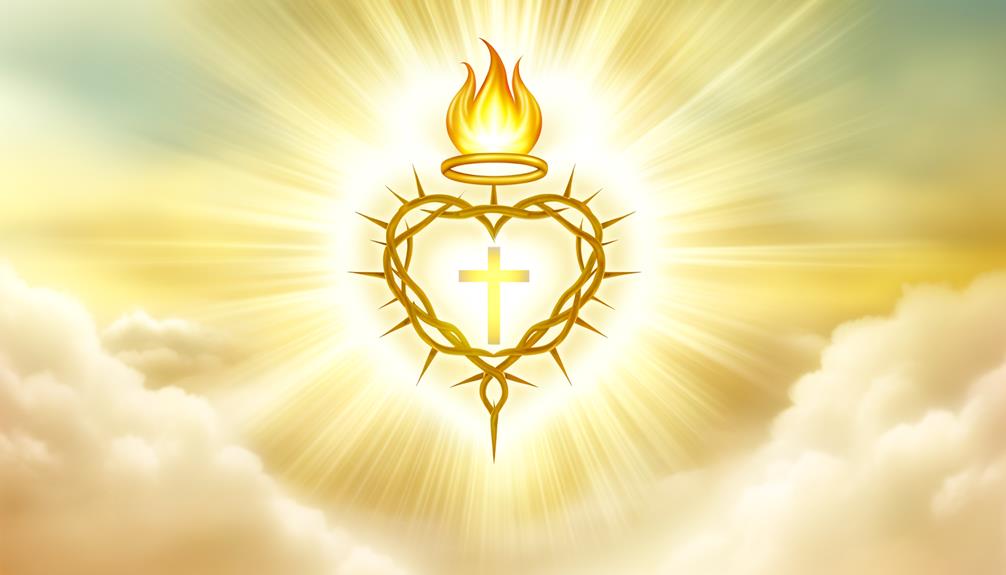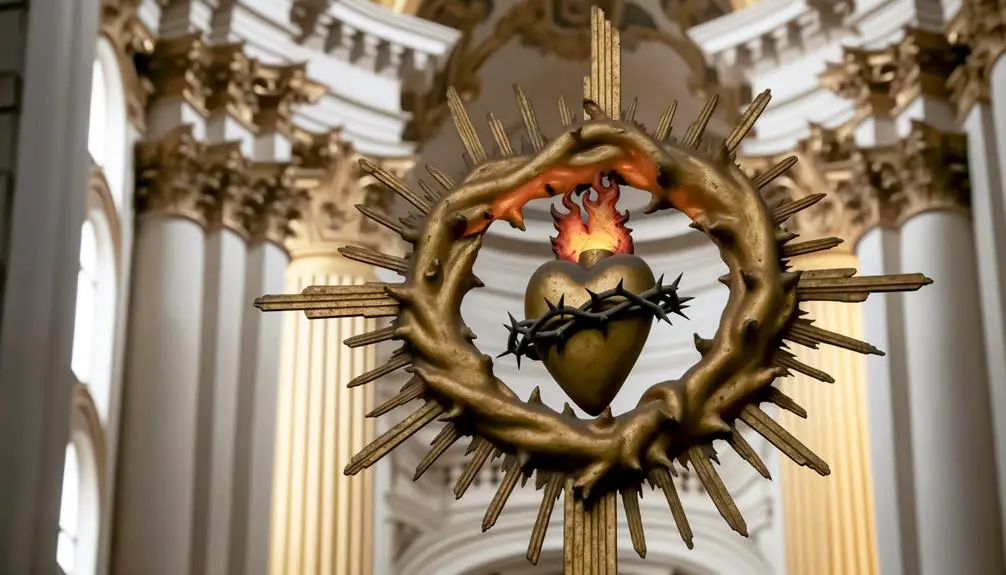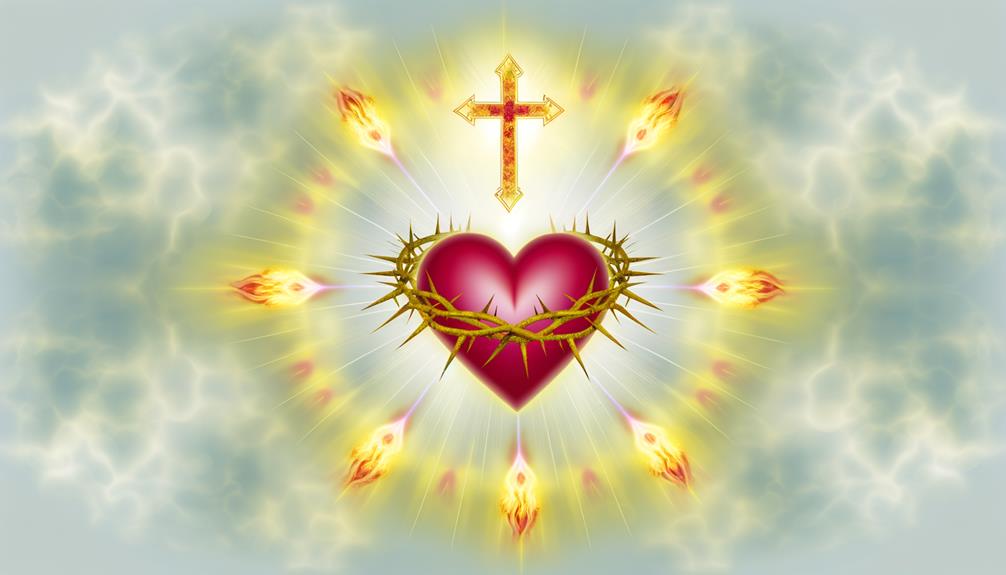What Does the Sacred Heart of Jesus Symbolize?
The Sacred Heart of Jesus symbolizes the infinite love and mercy of Christ. Rooted in the veneration of His physical heart, it emerged prominently through mystics like St.
Gertrude the Great and St. Margaret Mary Alacoque.
Features such as the crown of thorns, flames of ardent love, and the cross atop the heart intricately symbolize suffering, compassion, and redemption. This powerful imagery calls for spiritual renewal and underscores the interconnectedness of divine and human love.
Devotional practices like the Act of Consecration and First Friday Devotions embody this sacred message, inviting deeper exploration and spiritual transformation.

Key Takeaways
- The heart symbolizes Christ's boundless love and compassion for humanity.
- The crown of thorns represents Christ's suffering and sacrifice.
- Flames emanating from the heart signify Christ's ardent love.
- The cross atop the heart reminds of Christ's crucifixion.
- The wound on the heart reflects both physical and spiritual anguish.
Historical Origins

The historical origins of the Sacred Heart of Jesus symbol trace back to early Christian devotional practices and theological reflections. Initially rooted in the veneration of Christ's physical heart as the seat of divine love, this devotion gained prominence through the writings of mystics and saints.
By the Middle Ages, figures such as St. Gertrude the Great and St. Margaret Mary Alacoque significantly contributed to its widespread acceptance. Artistic depictions evolved, often illustrating a heart encircled by thorns and radiating divine light, symbolizing Christ's enduring love and sacrifice.
The Counter-Reformation period further solidified this devotion, as it became a powerful tool for spiritual renewal and personal piety, laying the groundwork for its enduring presence in Catholic spirituality.
Theological Significance
Central to the theological significance of the Sacred Heart of Jesus is its representation of Christ's infinite love and mercy towards humanity. This profound symbol encapsulates Jesus' willingness to endure suffering and sacrifice, ultimately manifesting as a call to spiritual renewal and conversion.
The Sacred Heart invites the faithful to deepen their relationship with Christ, emphasizing the redemptive power of divine love. It serves as a reminder of God's unwavering commitment to the salvation of souls, encouraging an intimate and personal devotion.
Theologically, the Sacred Heart underscores the interconnectedness of human and divine love, offering a tangible expression of the mysteries of the Incarnation and Redemption. Consequently, it becomes a focal point for understanding Christ's compassionate mission.
Symbolic Elements

Among the symbolic elements of the Sacred Heart of Jesus, the image of the heart itself stands as a profound emblem of divine love and compassion.
Encircled by a crown of thorns, the heart signifies Christ's suffering and sacrifice for humanity's salvation. The flames emanating from the heart symbolize the fervent love of Christ, a love that is both purifying and transformative.
Additionally, the cross often depicted atop the heart serves as a reminder of Christ's crucifixion and the redemption it offers. The wound on the heart, pierced by a lance, reflects the physical and spiritual anguish endured by Jesus.
These elements collectively encapsulate the depth of Christ's love and His enduring commitment to humanity's redemption.
Devotional Practices
In the domain of devotional practices, veneration of the Sacred Heart of Jesus encompasses a variety of rituals and prayers that seek to deepen the faithful's connection with Christ's divine love and sacrifice.
Devotees often engage in the First Friday Devotions, which include Mass attendance, receiving the Eucharist, and offering prayers of reparation. The Litany of the Sacred Heart and the Act of Consecration are also integral, invoking Christ's compassion and mercy.
Additionally, the practice of enthroning the Sacred Heart in homes and parishes symbolizes inviting Christ's presence into daily life. These devotions aim to cultivate a profound spiritual intimacy, reflecting upon the transformative power of divine love manifest in the Sacred Heart.
Modern Relevance

The enduring significance of the Sacred Heart of Jesus in contemporary spirituality lies in its ability to bridge traditional devotion with modern expressions of faith and social justice.
This symbol, deeply rooted in Catholic tradition, transcends ritualistic confines to inspire actions grounded in compassion, empathy, and universal love.
In an era marked by social inequities and moral crises, the Sacred Heart serves as a compelling call for believers to embody Christ-like love in addressing societal issues.
Through community outreach, charitable initiatives, and advocacy for the marginalized, the Sacred Heart's ethos is revitalized.
This makes it remain a potent emblem, not only of personal piety but also of transformative action in the pursuit of a more just and compassionate world.
Conclusion
The Sacred Heart of Jesus symbol, with its rich historical origins, profound theological significance, intricate symbolic elements, and enduring devotional practices, remains an essential aspect of contemporary spirituality.
Some may argue that its relevance has diminished in modern times; however, its enduring presence in religious art and community practices demonstrates a sustained resonance.
The symbol continues to offer a powerful means for believers to connect with the divine love and compassion epitomized by Jesus Christ.






